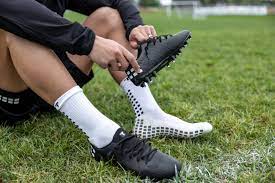The Science Behind Grip Technology in Sock Design

Introduction
Grip technology in sock design has become a game-changer, transforming traditional footwear into specialized accessories that offer enhanced stability and performance. This evolution goes beyond aesthetics, delving into the realm of biomechanics, soccer grip socks material science, and innovative engineering. In this exploration, we unravel the science behind grip technology in sock design, showcasing how it has evolved to cater to the diverse needs of athletes and individuals in various activities.
Biomechanics and Pressure Points
The foundation of grip technology lies in an understanding of biomechanics and the pressure points of the human foot. Engineers and designers meticulously study how the foot interacts with different surfaces during activities such as running, jumping, or pivoting. By identifying high-friction areas and pressure points, they can strategically place grip-enhancing elements in the sock’s design, optimizing traction and stability.
Material Science: Silicone and Rubber Integration
The choice of materials is critical in developing effective grip technology. Silicone and rubber have emerged as key components due to their superior grip properties and durability. Manufacturers strategically integrate these materials into the sock’s sole, creating patterns that provide optimal traction without compromising comfort. The balance between flexibility and resilience ensures that the grip technology effectively responds to the dynamic movements of the foot.
Surface Interaction and Friction Coefficients
The science behind grip technology also involves an in-depth analysis of surface interaction and friction coefficients. Engineers consider the type of surface the sock will be in contact with, whether it’s a gym floor, a yoga mat, or a basketball court. By tailoring the grip patterns to specific surfaces, designers can optimize the coefficient of friction, ensuring a secure grip that minimizes slippage and enhances overall performance.
Targeted Compression and Support
Beyond grip, the science of sock design encompasses targeted compression and support. Socks with integrated compression elements can enhance blood circulation, reduce muscle fatigue, and provide additional support to key areas of the foot. This holistic approach to sock engineering ensures that grip technology works in synergy with other features, contributing to overall comfort and performance.
Specialized Designs for Different Activities
The science of grip technology extends to the customization of sock designs for various activities. Whether it’s a runner needing impact absorption, a basketball player requiring lateral support, or a yogi seeking stability in complex poses, manufacturers use biomechanical insights to tailor grip patterns and material compositions accordingly. This specialization ensures that the sock meets the specific demands of each activity, enhancing both safety and performance.
Conclusion
In conclusion, the science behind grip technology in sock design is a multidisciplinary endeavor that combines biomechanics, material science, and a deep understanding of human movement. As engineers continue to refine these technologies, the resulting custom socks not only provide superior grip but also contribute to overall foot health, comfort, and performance. The evolution of grip technology is a testament to the ongoing commitment to scientific innovation in the pursuit of creating socks that not only look good but also revolutionize the way we move.




